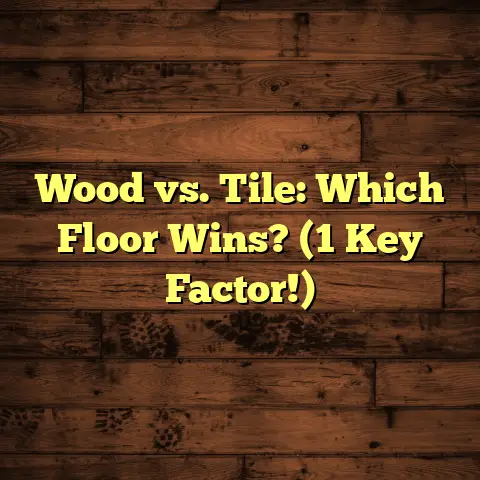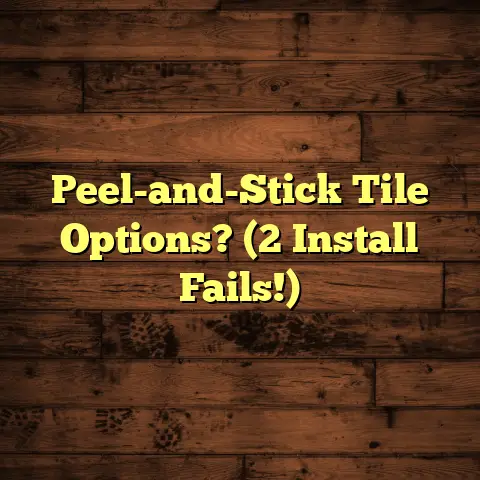Cork Backing For Vinyl Plank? (9 Backing Facts!)
We all want that space that feels good, looks amazing, and just works for our lives, right?
That’s what I call a lifestyle upgrade, and it starts from the ground up – literally!
Flooring is a game-changer, and these days, vinyl plank is super popular. Why?
It’s easy on the wallet, looks fantastic, and you can even install some types yourself.
But here’s a secret weapon to make it even better: cork backing.
Now, you might be thinking, “Cork? Like in wine bottles?” Well, kind of!
But trust me, adding cork to your vinyl plank is a brilliant move.
So, what makes cork backing such a smart choice for homeowners looking to elevate their flooring experience?
Let’s dive into the facts!
Section 1: What is Cork Backing?
Okay, so what exactly is cork backing?
Simply put, it’s a layer of cork attached to the underside of your vinyl plank.
This isn’t just any cork; it’s typically made from granulated cork that’s been compressed and bonded together.
Think of it like a super-dense corkboard, but designed specifically for flooring.
How Cork is Harvested and Processed
Here’s where it gets cool.
Cork comes from the bark of cork oak trees, mainly found in Portugal and Spain.
The best part?
Harvesting the cork doesn’t harm the tree!
Skilled workers carefully strip the bark every nine years, and the tree continues to grow and regenerate.
This makes cork a truly renewable resource.
Once harvested, the cork bark is processed.
It’s boiled, which makes it more pliable and easier to work with.
Then, it’s ground into granules and formed into sheets that can be used for all sorts of things, including flooring underlayment.
Eco-Friendly Properties and Sustainability
I can’t stress enough how awesome cork is for the environment.
Because the trees aren’t cut down, cork forests continue to thrive, absorbing carbon dioxide and supporting biodiversity.
According to the Cork Quality Council, cork forests
retain around 14.7 million tons of CO2 every year.
That’s like taking 3 million cars off the road!
Choosing cork-backed vinyl plank is a vote for sustainability.
Cork Backing vs. Other Types of Flooring Backings
So, how does cork stack up against other backings like foam or rubber?
Let’s take a look:
As you can see, cork holds its own, especially when it comes to being eco-friendly, sound absorption, and thermal insulation.
Section 2: The Benefits of Cork Backing for Vinyl Plank Flooring
Alright, let’s get to the good stuff: what makes cork backing so beneficial for your vinyl plank flooring?
Sound Absorption
One of the biggest advantages is sound absorption.
Cork is naturally porous, which means it can trap and dampen sound waves.
Think about how corkboards in offices help reduce echo.
It works the same way under your floors!
With cork backing, you’ll notice a significant reduction in noise, especially from footsteps and dropped objects.
This is a game-changer if you live in an apartment, have kids, or just want a more peaceful home.
I’ve seen firsthand how cork backing can transform a noisy space into a tranquil haven.
Thermal Insulation
Cork is also a fantastic insulator.
It helps keep your floors warmer in the winter and cooler in the summer.
This is because cork contains millions of tiny air-filled cells that act as a natural barrier to heat transfer.
According to the Portuguese Cork Association, cork has a thermal conductivity coefficient of around 0.040 W/mK, which is similar to that of many common insulation materials.
By reducing heat loss in the winter and heat gain in the summer, cork backing can even help lower your energy bills.
Comfort Underfoot
Let’s be honest, walking on hard floors all day can be tough on your feet and joints.
Cork backing provides a cushioning effect that makes your vinyl plank flooring much more comfortable to walk on.
It has a natural give that absorbs impact and reduces strain.
I’ve had clients who swear their cork-backed floors have made a noticeable difference in their overall comfort, especially if they spend a lot of time on their feet.
Moisture Resistance
While not completely waterproof, cork is naturally resistant to moisture.
It contains a waxy substance called suberin that repels water and prevents it from penetrating the material.
This can help protect your vinyl plank and subfloor from water damage, especially in areas like kitchens and bathrooms.
However, it’s still crucial to address any spills or leaks promptly to prevent moisture from seeping in over time.
Durability
Cork-backed vinyl planks are generally more durable than those without.
The cork layer provides extra support and helps distribute weight evenly, reducing the risk of dents and scratches.
It also acts as a shock absorber, protecting the vinyl plank from impact damage.
While no flooring is completely indestructible, cork backing can definitely extend the lifespan of your vinyl plank floors.
Section 3: Installation Considerations
So, you’re sold on cork-backed vinyl plank? Awesome! Let’s talk about installation.
Installation Process
The installation process for cork-backed vinyl plank is similar to that of regular vinyl plank.
The main difference is that you don’t need to install a separate underlayment since the cork backing is already attached.
This can save you time and money.
Floating vs. Glue-Down Methods
There are two main installation methods: floating and glue-down.
Floating: This method involves clicking the planks together and letting them “float” over the subfloor.
It’s generally easier and faster, making it a popular choice for DIYers.Glue-Down: This method involves adhering the planks directly to the subfloor with adhesive.
It provides a more stable and permanent installation, but it’s also more labor-intensive.
For cork-backed vinyl plank, floating installation is often preferred because the cork backing helps to cushion and insulate the floor, reducing the need for a glued-down installation.
Importance of Acclimation and Preparation of the Subfloor
Before you start installing, it’s crucial to acclimate the vinyl planks to the room’s temperature and humidity for at least 48 hours.
This allows the planks to expand or contract, preventing gaps or buckling after installation.
Also, make sure your subfloor is clean, level, and dry.
Any imperfections in the subfloor can telegraph through
the vinyl plank, so it’s worth taking the time to prepare
it properly.
Tools and Tips for DIY Enthusiasts
If you’re a DIY enthusiast, installing cork-backed vinyl plank can be a rewarding project.
Here are a few essential tools you’ll need:
- Measuring tape
- Utility knife
- Straight edge
- Tapping block
- Pull bar
- Spacers
And here are a few tips to make the process smoother:
- Start in a corner and work your way across the room.
- Use spacers to maintain consistent gaps along the walls.
- Tap the planks together gently to avoid damaging the edges.
- Don’t be afraid to ask for help if you get stuck!
Section 4: Maintenance and Care
Okay, you’ve got your beautiful cork-backed vinyl plank floors installed.
Now, how do you keep them looking their best?
Best Practices for Cleaning
The good news is that cork-backed vinyl plank is relatively easy to clean and maintain.
Regular sweeping or vacuuming is usually enough to remove dirt and debris.
For deeper cleaning, use a damp mop and a mild, pH-neutral cleaner.
Importance of Using Non-Abrasive Cleaners
Avoid using abrasive cleaners or scrub brushes, as these can scratch or dull the surface of the vinyl.
Also, be careful not to use too much water, as excess moisture can seep into the seams and damage the subfloor.
Tips on Preventing Scratches and Dents
To prevent scratches and dents, use furniture pads under heavy objects and avoid dragging furniture across the floor.
You can also use mats or rugs in high-traffic areas to protect the flooring from wear and tear.
Common Misconceptions About Cork Backing and Its Maintenance
One common misconception is that cork backing requires special maintenance.
In reality, it’s just as easy to care for as regular vinyl plank.
Another misconception is that cork backing is easily damaged by water.
While it’s not completely waterproof, it is moisture resistant and can withstand normal household spills.
Section 5: Aesthetic Diversity of Cork-Backed Vinyl Plank
Let’s talk style!
One of the great things about vinyl
plank is the sheer variety of looks you can achieve, and
cork backing doesn’t limit that at all.
Design Options Available
You can find cork-backed vinyl planks in a huge range of colors, textures, and styles.
Want something that looks like real hardwood?
No problem!
Prefer a modern, minimalist look?
There are plenty of options for that too.
The possibilities are endless.
Complementing Interior Design Themes
Cork backing works well with just about any interior design theme.
- Modern: Pair light-colored vinyl planks with clean lines and minimalist decor.
- Rustic: Choose wood-look planks with a distressed finish for a cozy, farmhouse feel.
- Coastal: Opt for light, airy colors and natural textures to create a beachy vibe.
Popular Trends in Flooring
Some of the most popular trends in flooring right now include wide-plank vinyl, herringbone patterns, and waterproof options.
Cork backing can be added to any of these styles to enhance their comfort and performance.
Section 6: Cost Analysis
Let’s talk numbers.
How much does cork-backed vinyl plank flooring actually cost?
Costs Associated with Cork-Backed Vinyl Plank Flooring
The cost of cork-backed vinyl plank flooring can vary depending on the quality of the materials, the thickness of the cork backing, and the complexity of the installation.
On average, you can expect to pay between $3 and $7 per square foot for the materials alone.
Installation costs can range from $2 to $5 per square foot, depending on whether you hire a professional or do it yourself.
Long-Term Value
While cork-backed vinyl plank may have a higher upfront cost than some other flooring options, it can offer significant long-term value.
Its durability and moisture resistance can help prevent costly repairs and replacements down the road.
Plus, its thermal insulation properties can lower your energy bills, saving you money over time.
Potential Cost Savings
By reducing noise levels, cork backing can also create a more peaceful and productive home environment.
This can be especially valuable if you work from home or have kids who need a quiet space to study.
Section 7: Environmental Impact
We touched on this earlier, but let’s really dig into the environmental impact of choosing cork-backed vinyl plank.
Eco-Friendly Aspects of Cork
Cork is one of the most sustainable materials on the planet.
As I mentioned, harvesting cork doesn’t harm the trees, and cork forests play a vital role in carbon sequestration and biodiversity conservation.
Environmental Benefits
Choosing cork-backed vinyl flooring over traditional flooring materials like hardwood or carpet can have a significant positive impact on the environment.
It reduces the demand for virgin resources and helps support sustainable forestry practices.
Certifications and Standards
Look for certifications like the Forest Stewardship Council (FSC) to ensure that the cork used in your flooring comes from responsibly managed forests.
Other certifications, such as the FloorScore label, indicate that the flooring has been tested for low VOC emissions, making it a healthier choice for your home.
Section 8: Customer Experiences and Testimonials
Okay, enough from me!
Let’s hear from some real homeowners
who have installed cork-backed vinyl plank flooring.
Real-Life Stories
I’ve had clients tell me how much they love their cork-backed floors.
One family said it completely transformed their basement, making it warmer, quieter, and more comfortable for their kids to play in.
Another homeowner raved about how easy it was to clean and maintain, even with pets and kids.
Specific Improvements
Many homeowners report a noticeable reduction in noise levels after installing cork-backed vinyl plank.
They also appreciate the added comfort underfoot and the peace of mind that comes with knowing their floors are protected from moisture damage.
Positive and Constructive Feedback
Of course, no product is perfect.
Some homeowners have noted that cork-backed vinyl plank can be slightly more expensive than other flooring options.
Others have mentioned that it’s important to choose a high-quality product to ensure durability and longevity.
Overall, though, the vast majority of homeowners who have installed cork-backed vinyl plank are extremely satisfied with their investment.
Conclusion
So, there you have it!
Cork backing for vinyl plank is a fantastic way to elevate your lifestyle and create a more comfortable, stylish, and sustainable home.
From its sound-absorbing properties to its thermal insulation and eco-friendly credentials, cork backing offers a wide range of benefits that can enhance your flooring experience.
By choosing cork-backed vinyl plank, you’re not just investing in new floors; you’re investing in a better quality of life.
You’re creating a space that’s more peaceful, more comfortable, and more environmentally friendly.
And who wouldn’t want that?
Call to Action
Ready to transform your home with cork-backed vinyl plank flooring?
Explore the various design options available and envision the transformation it could bring to your living spaces.
Talk to your local flooring contractor and ask about the benefits of cork backing.
With a little research and planning, you can create the floors of your dreams and elevate your lifestyle to a whole new level.





